Transformation & Metamorphosis
by Michele Corriel
Above: Pensive | 24”x 30” | Oil on canvas | Angela Zanolari
Each of the stories in this Art Section seeks to understand the fluid boundaries of what makes fine art. The artists all communicate an overriding sense of optimism and an abundance of curiosity, encouraging the viewer to take a second look at the world.
From taking rusty, broken wire and turning it into an elegant portrait of the wind, to black and white fine art photography that includes a nod to Warhol and a pinch of diamond dust, to the inner voice of an artist finding herself on the canvas, to the sisters who create not just painting but transform the meaning of place for their clients, they each explore their individual creativity, and their unique perspectives come across loud and clear.
Enter the studio of Kevin Noble who found a way to capture a weather phenomenon in his exquisite black and white photographs of Yellowstone Park; or the workshop studio of Jennifer Pulchinski who tames barbed wire into sculptural tranquility. Angela Zanolari unleashes her creative soul onto the pages of her journal, and sisters Terry Hall and Kathi Gerritsen work to help their clients understand their own environments through painting, photography, and digital art.
By exploring these artists and galleries, the hope is to further the reader’s interest in more than just a second look, and to understand the creative process on a deeper level.
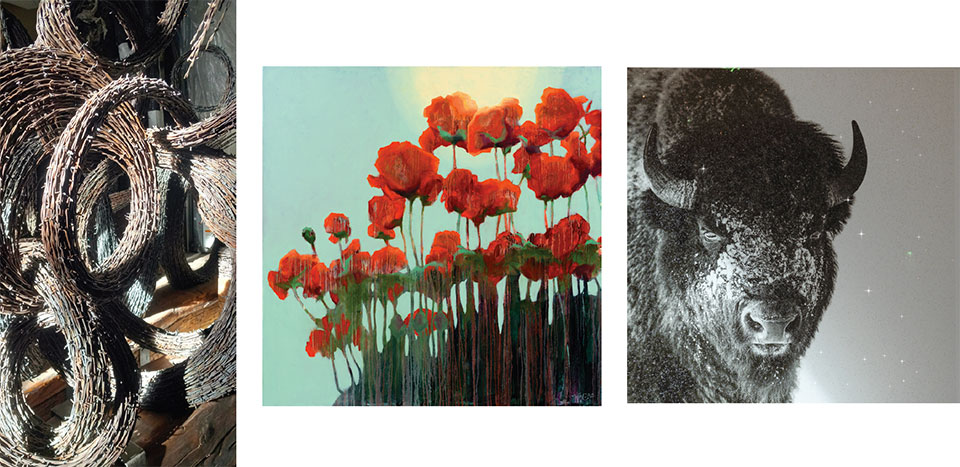
Left: Water Whispers Detail | 48”x 58”x 24” | Barbed wire, steel, & reclaimed timber | Jennifer Pulchinski
Center: Dancing Redheads | 48” x 48” | Oil on Canvas Wrap Sanguine Fine Art & Boutique
Right: The Mask | 43” X 43” | Photography with “diamond dust” finish | Kevin Noble
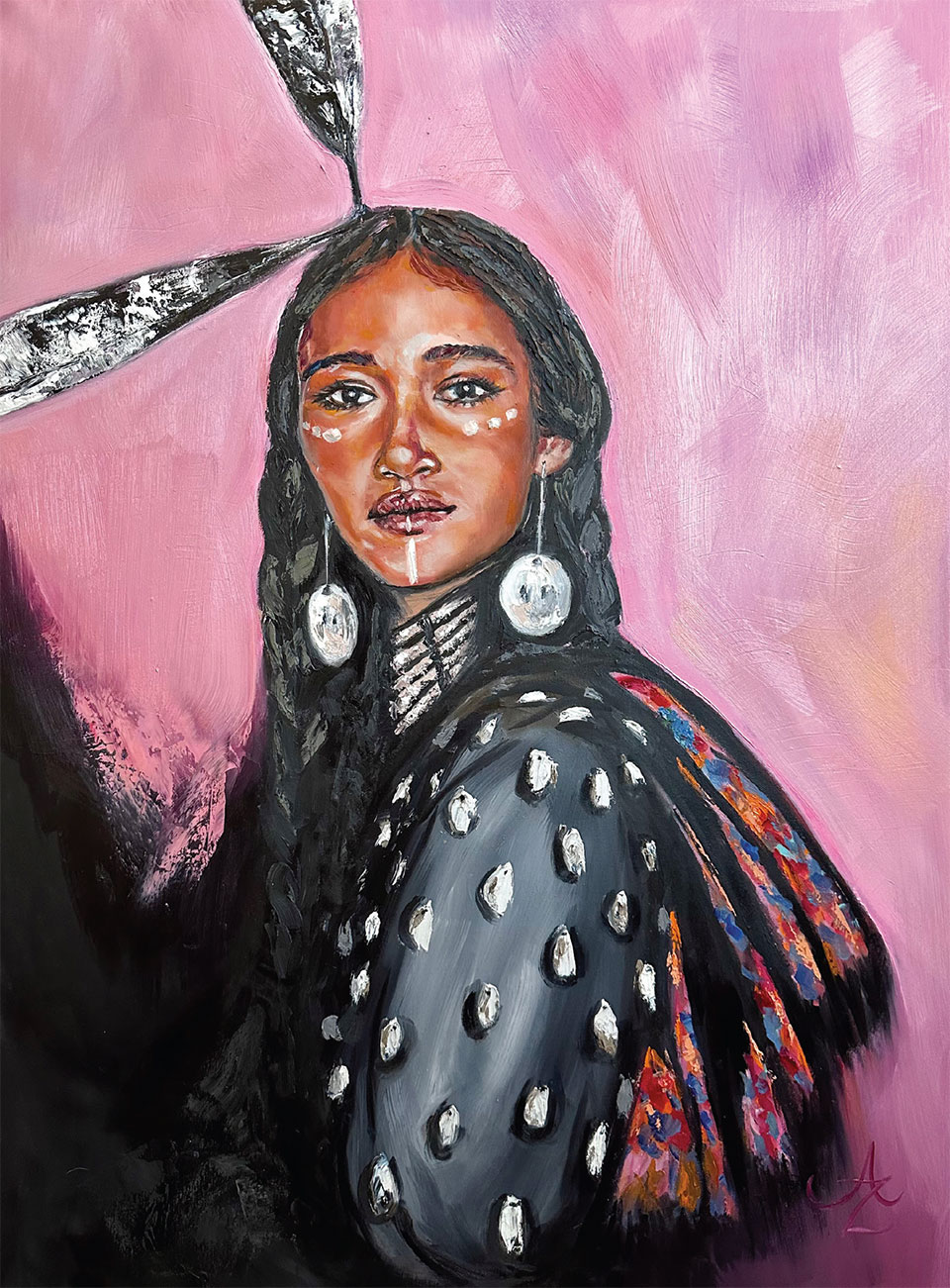
Two Feathers | 30” x 40” | Oil on canvas
Angela Zanolari
Following the Colors in Her Heart
When painter Angela Zanolari opens her sketchbook, her personal experience with the world is revealed. Pages, crinkled and thick from wet colors, expose joyous discoveries that emerge with each new image.
Like finally tearing off the band-aid to find skin, fresh and new, her sketchbook, like a private journal, seems vulnerable. The pages feel like a map guiding Zanolari through a journey of finding her voice. That journey, her own personal journey, has brought her around the world from her home in Thailand to locations in Europe and now, to the American Rockies.
“I work with my own instinct. When I get in the zone it feels like I am channeling, and I am often surprised by what happens. I don’t know where it comes from.”
–Angela Zanolari, Artist
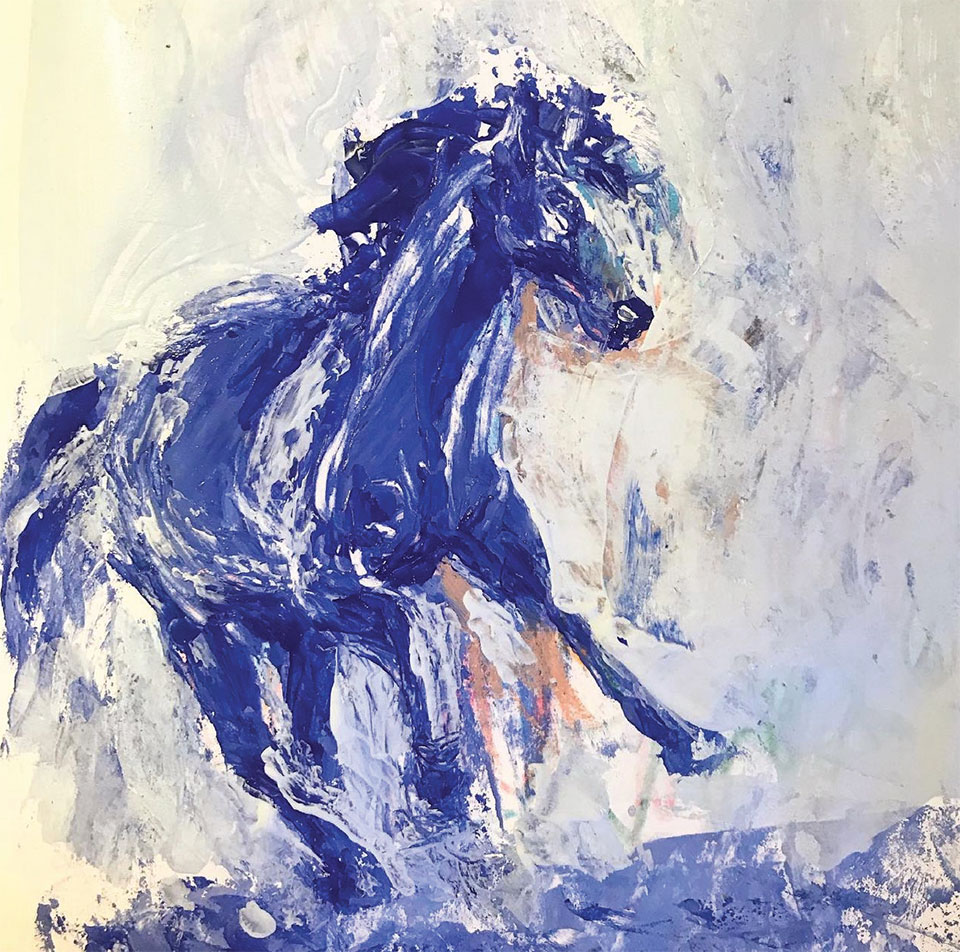
Blue Horse | 8” x 12” | Acrylic on paper
Each day in the studio opens up to reveal more meaning for Zanolari, like an unveiling, a rebirth, a glittering discovery for the artist whose path emerges before her. Each turn of the journal page uncovers her courageous steps into authenticity, leaving behind the ghosts of cliches, so easy to cling to, and instead braving the brushstrokes that speak to her own identity.
“I work with my own instinct,” Zanolari says. “When I get in the zone it feels like I am channeling, and I am often surprised by what happens. I don’t know where it comes from.”
The creative process is often hard to define. As Henri Matisse is known to have once said, “Creativity takes courage.” It is often with this type of courage that Zanolari approaches her time in the studio.
In her painting, Blue Horse, energy bursts forth from the canvas. Zanolari creates movement, the hooves leap from the ground. Every brushstroke feels electric, throwing power up through the earth. Even the background, like snow or wind feels kinetic, as the breath of color whispers from beneath the surface.
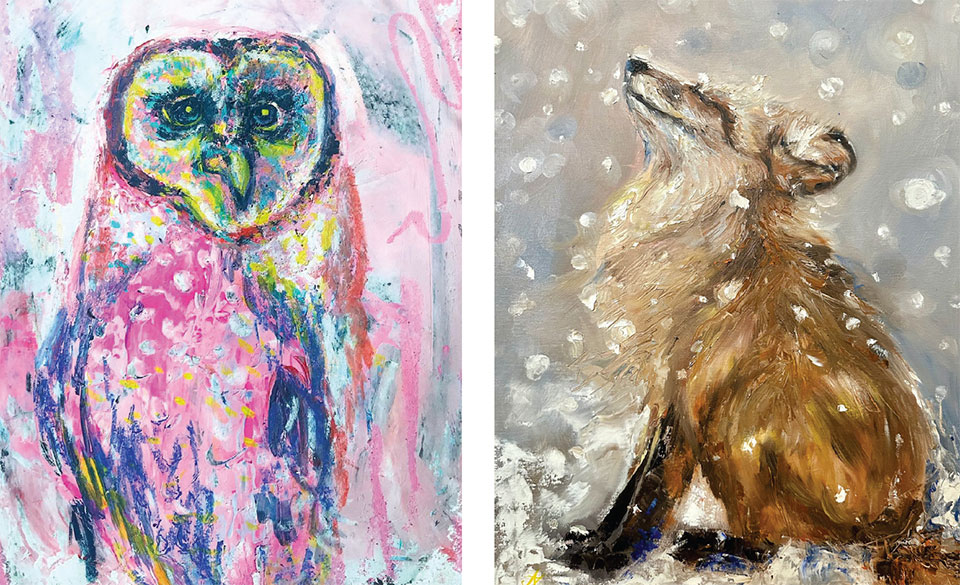
Left: Pink Owl | 8” x 12” | Mixed media on paper
Right: Fox in Snow | 18” x 24” | Oil on canvas
Zanolari’s studio, located in the Emerson Center for the Arts and Culture, exudes a mixture of cozy and creative. Her diffuser emits a soft essence and she maintains a tea meditation corner in her studio. Worktables, both for painting and for her computer, delineate different tasks for her day. If she’s not working on a commission piece, she often will take out her oil pastels and acrylic paints just to see where it will take her. Without preconceived notions of the subject, she allows her brushes to dip and glide across the surface. A clear mind can sweep away the clutter; for Zanolari, her process and lifelong habits of listening to her intuition guide her artistic practice.
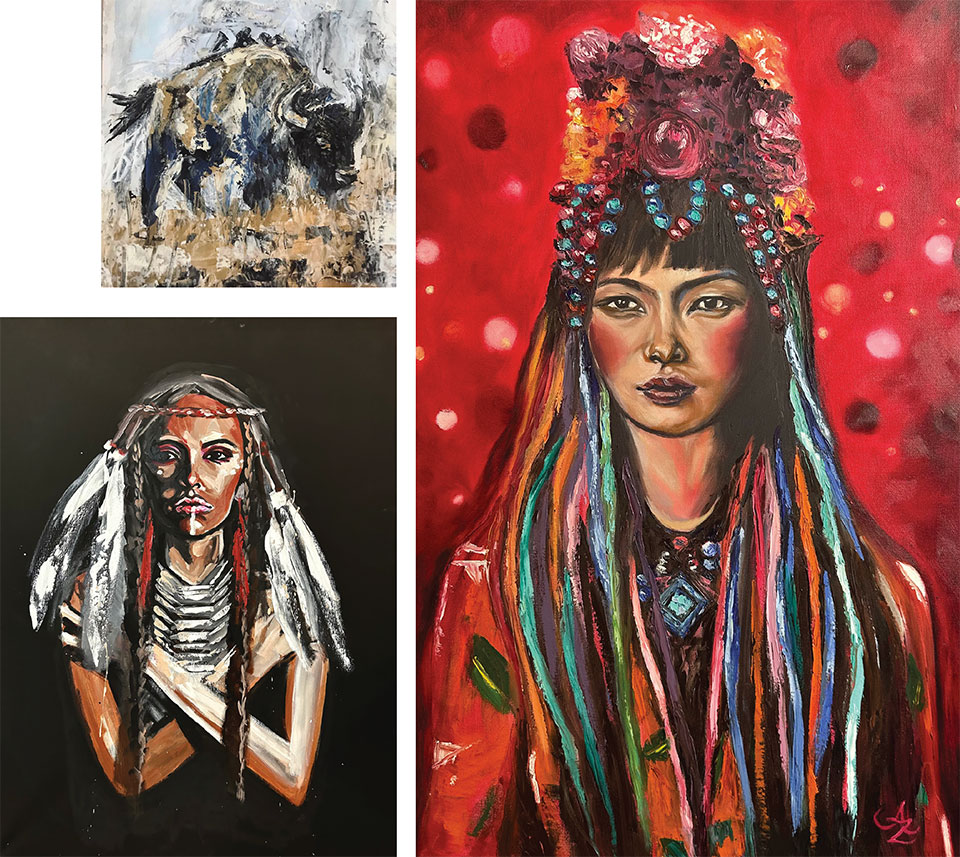
Top Left: Bison and companions | 10”x 10” | Acrylic on paper
Right: Jade Strength | 24” x 30” | Oil on canvas
Bottom Left: Embrace no. 5 | 30” x 40” | Oil on canvas
“I consider myself immensely fortunate to have been deeply shaped by the diverse influences of Asian, European, American, and Indigenous cultures. It is the fusion of these vibrant cultural threads, intertwined with my unwavering reverence for the natural world, that breathes life into my artwork.”
–Angela Zanolari, Artist
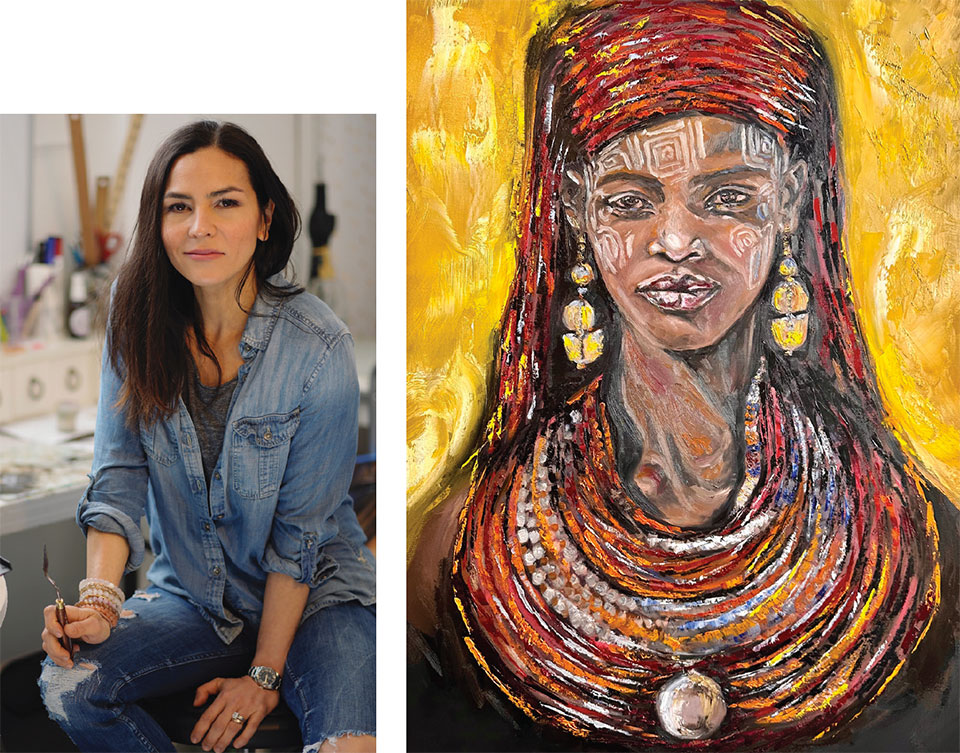
Golden Spirit | 30” x 40” | Oil on canvas
Zanolari grew up in Thailand with a Swiss/Italian father and a Chinese mother. Her decidedly exotic look got her roles in a few movies and a lot of soap operas in Thailand. Acting didn’t scratch that itch for her, but her love of the outdoors and her competitive spirit came through in martial arts, tennis, and water-skiing (where she was on the national water-skiing team). Today in Montana, she has taken up ice hockey, a sport played by her husband and children.
Like everything she does, she committed totally to competitive sports and ended up breaking her wrist during her jiujitsu practice. However, that did not hamper her spirit. Instead, she turned a negative into something positive and reached for her paintbrushes.
Throughout her life, she’s always painted, but she never thought of it as a career. Zanolari graduated from college in Thailand with an art degree and pursued art more as a hobby. Once in Bozeman, she found a connection with some of the local artists. Her move into the Emerson, surrounded by creative people, seems to have spurred her forward.
In her studio, she lets the paint guide her. The immediate and primal brushstrokes call to something in her. Perhaps it’s her love of the natural world, or her own spirituality that comes out in the bright hues and muted shades. “I just start doing my own thing,” she says. “It feels great.”
Her artist’s statement reveals the profound impact of nature, wildlife, and the tapestry of her cultural experiences that have culminated in the person she is today.

Left: Bee and Pollen | 12”x 12” | Oil on canvas
Center: Enchanted Elk | 24” x 30” | Acrylic on canvas
Right: Magic Hour Jewel | 18”x 24” | Oil on canvas
“I consider myself immensely fortunate to have been deeply shaped by the diverse influences of Asian, European, American, and Indigenous cultures. It is the fusion of these vibrant cultural threads, intertwined with my unwavering reverence for the natural world, that breathes life into my artwork,” she states. “Furthermore, my art reflects my steady belief in a wholesome and balanced lifestyle, guided by the awe-inspiring power of God’s creation. Montana, with its unspoiled natural beauty, stands as a poignant symbol of this divine craftsmanship, which consistently guides and inspires my creative endeavors.”
In one of Zanolari’s recent pieces, a small painting of a buffalo, the thickly applied paint implies the heft of the animal. She shows dynamism by grounding the buffalo with short, quick brushstrokes, and in the air surrounding him with a slight swirling of color. It’s not a duplicate of a photograph, but rather the impression one has when confronted with such a huge creature. It’s beautiful and significant. It knows its place.
Although her work is not strictly “feminine,” Zanolari does seem to channel a tender adventurism into color and composition. “For me, it’s spiritual. I like to follow my heart,” she says. “I’m coming from a pure place, although at the moment I’m just beginning to explore.”
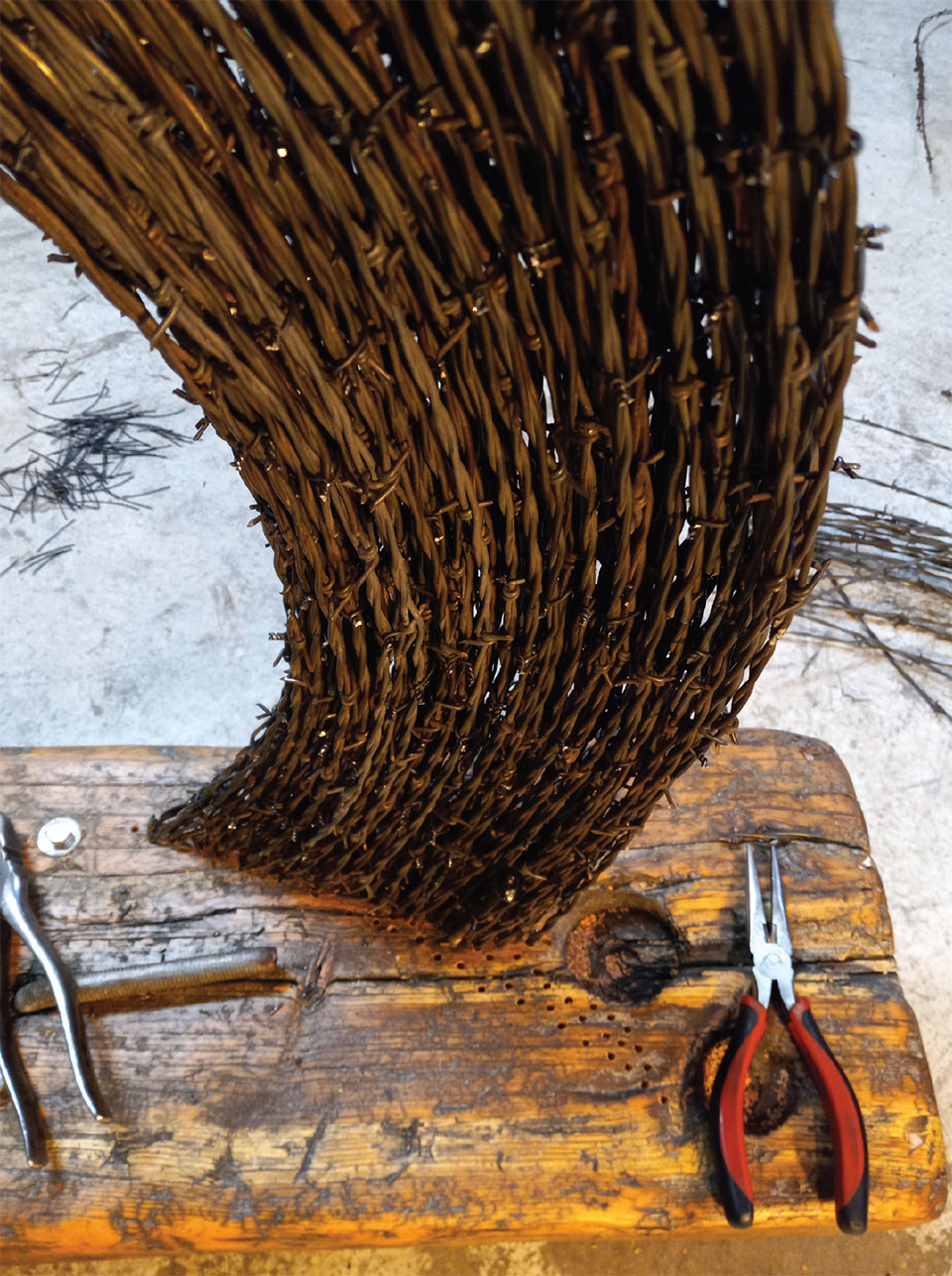
Detail of Pulchinski’s process.
Jennifer Pulchinski
at Old Main Gallery
Barbed wire’s long and infamous history goes back to the 1870s and has wound its way through prisons and riots, through range wars and cattle grazing fights. Jennifer Pulchinski wrangles found barbed wire into powerful yet elegant sculptures.
In her studio, random pieces of cut wire lie scattered across the floor, circles of barbed wire tower, stacked along the back, and frames populated with barbed wire trees climb the walls. Her larger pieces whirl and eddy, while reaching skyward toward a single point, elegant as a dancer.
She discovered the versatility of barbed wire while still a student, getting her art degree.
“There I was standing in a field,” she recalls. “It was a hot day, not a cloud in the sky. I was surrounded in blue – the sky was endless.”
At the time, she was taking a sculpture class but had not figured out what to use for her medium.
“I was on a mission; I needed to make something, anything. Seeking and searching for an idea. I had the creativity, that feeling in my body that makes me move, makes me feel, and makes me want to translate it into something. I had the fuel, but I was missing something.”
–Jennifer Pulchinski, Artist
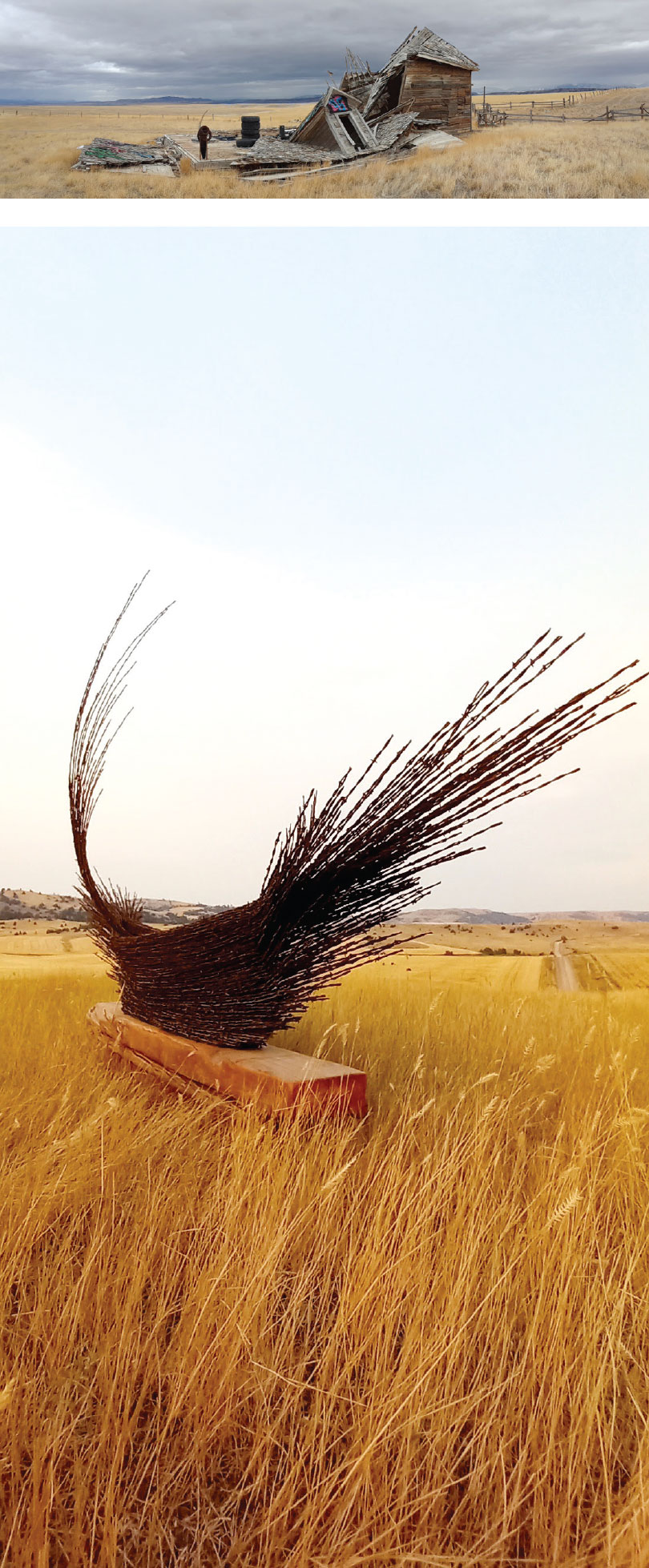
Installation of Nicola Hicks: Marks on the Wall, at Maya Frodeman Gallery, June 9th through July 30th, 2023
“I was on a mission; I needed to make something, anything,” she says. “Seeking and searching for an idea. I had the creativity, that feeling in my body that makes me move, makes me feel, and makes me want to translate it into something. I had the fuel, but I was missing something.”
As she continued her walk, she began to pay attention to the wind. “It felt nice, soft, on such a hot day. I heard a light rustle in the field from the tall grasses moving and I thought, wow, not so much blue anymore but yellow! I was surrounded by shades of yellow.”
But it was the movement from the wind that caught her attention.
“As I looked down, I saw it! A huge pile of discarded, used, and rusting barbed wire. Seeing that pile, with the misshapen forms it made, that was it,” she remembers.
Lindsey McCann, owner of Old Main Gallery, has been working with Pulchinski since 2016.
“I remembered seeing her work behind the Bozeman Public Library along the Gallagator trail and I also saw the one she made that is installed on the Montana State University campus,” McCann says. “It was a really good framing client who went to school with Jen and told us to check out her work.”
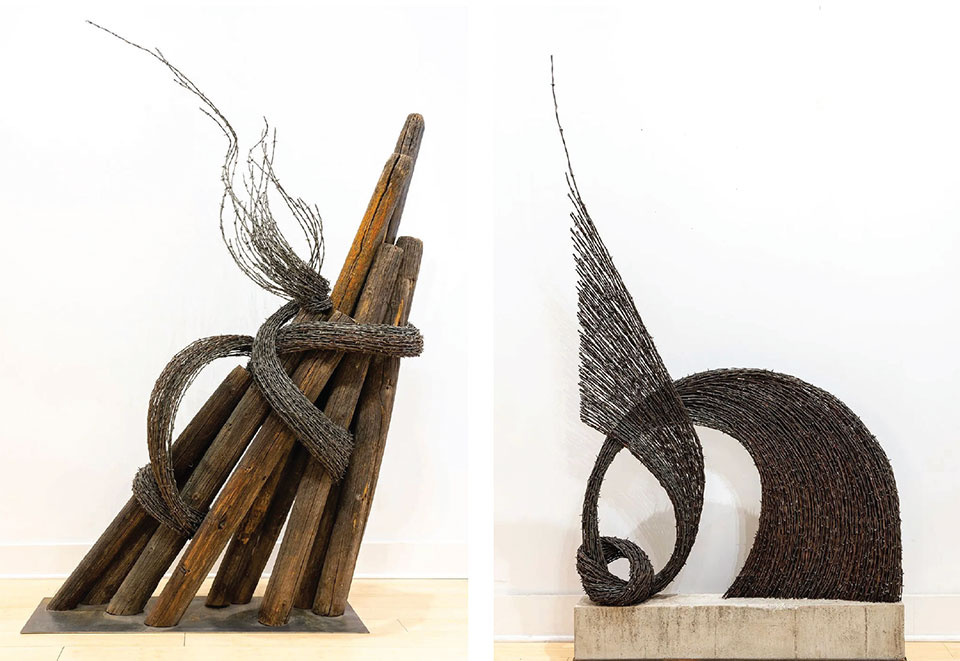
Left: Whispers | 86”x 52”x 15” | Barbed wired & reclaimed timber
Right: Wind Rights II | 74”x 40”x 5” | Barbed wire & concrete
It didn’t take McCann long to invite Pulchinski into the gallery, where there is usually at least one of her pieces visible from the window.
“I just absolutely adore her as a person and as an artist,” McCann says. “Her sculptures always bring people inside the gallery – and people are always surprised that she’s a woman.”
Maybe it’s the barbed wire. Maybe it’s the strength of her work. Most importantly, for McCann, it’s the pure joy.
“Each piece has its own energy,” McCann says. “She lets the materials dictate her work and she continues to amaze. Plus, she’s a wonderful storyteller: she makes me laugh.”
When clients walk into Old Main Gallery, they are constantly in awe of Pulchinski’s work, hardly able to believe or even conceive that the sculptures are made of barbed wire – found and collected barbed wire.
“They’ll stare at it and try to figure out how she does it,” McCann says. “They will circle the piece several times in utter disbelief.”
As far as installing her pieces, McCann says if people have concerns, they can either ask Old Main to install it safely or have it placed outdoors.
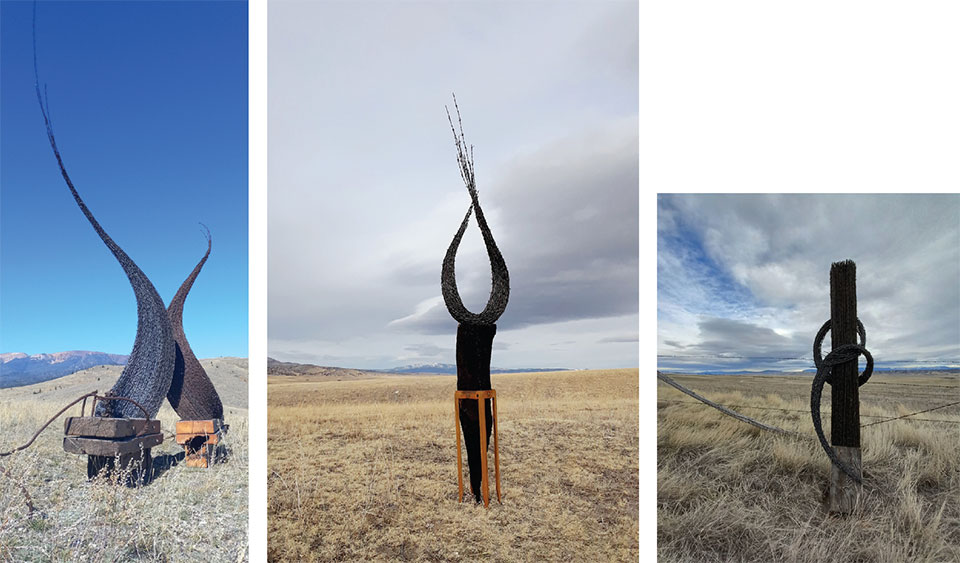
Left: Ghost Ships | 96”x 48”x 120” | Barbed wire & reclaimed timber
Center: Lombard III | 91”x 16”x 16” | Barbed wire, railroad tie, & steel
Right: The Post | 68”x 12”x 12” | Barbed wired & reclaimed timber
“Each piece has its own energy. She lets the materials dictate her work and she continues to amaze.”
–Lindsey McCann, Owner, Old Main Gallery
Back in the studio, surrounded by her primary materials, Pulchinski sits close to the concrete floor and absent-mindedly grasps a small piece of the barbed wire, immediately smoothing it out. Entranced by the inherent movement of triple-twisted and rusted wire, she pulls on it, her hands strong from this practice. “There’s a flow of movement within the barbed wire,” she says, still pulling and cajoling the wire to obey. “I’m constantly learning with it.”
Each piece brings with it years upon years of experience. Scraps of fur and hide, seeds, and grass cling to the barbs like wishes.
“There’s a natural flow,” she says. “Part of it is the memory of the wire and just letting it be itself.”
It’s exciting and dangerous. The barbs are sharp and biting. However, Pulchinski doesn’t dull them. She likes the fight of the wire and the daring beauty. Her ability to bend the wire into the design she holds in her mind seems to defy the nature of the crooked and somewhat corroded material.
“There’s a randomness that I depend on. It opens a creative door in my mind. The wire has a voice and a song to it.”
–Jennifer Pulchinski, Artist
“There’s a randomness that I depend on,” she says. “It opens a creative door in my mind. The wire has a voice and a song to it.”
Everything that Pulchinski uses in her work is found in the wild. She hikes into the backcountry, while picking up strands of abandoned wire that lay entwined in weeds and grasses. She then coils it up and takes it back to her studio. She also gathers old pieces of wood and fallen logs to which she adheres her barbed sculptures. Sometimes they have weathered and frayed cables attached. All the better. “Everything becomes part of the story,” she says. “Once I had a piece for three years before I realized what it wanted to become.”
Picking up a long-handled wire cutter, she snips at a stray strand of wire. Metal clatters to the floor.
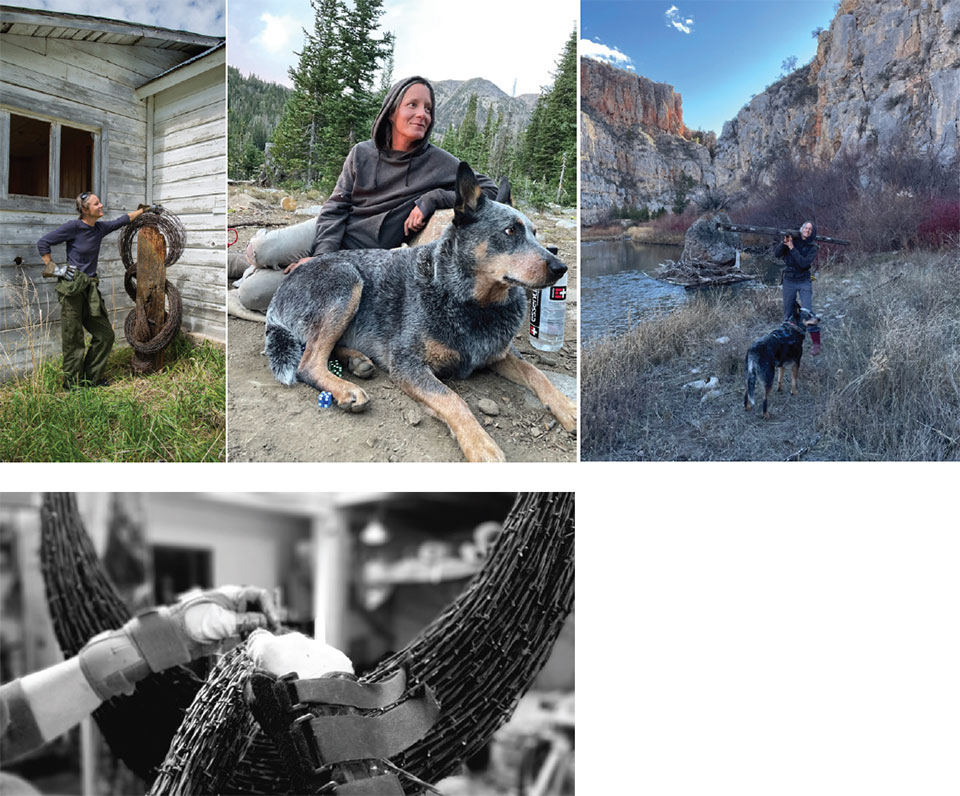
“I am constantly open to the process. I am still learning, experimenting, and trying to sculpt the wind.”
–Jennifer Pulchinski, Artist
“For this one, I wanted to experiment with the idea of unfinished circles,” she says, as the tamed wires coalesce into a single form. “I wait to get a feel for where the piece needs more weight, more shape.”
At first, her process felt like weaving, but her practice evolved over 20 years of working with this savage material. Now, she intuitively knows what the pieces need, and how to make the wire feel fluid and soft.
“But I am constantly open to the process,” Pulchinski says. “I am still learning, experimenting, and trying to sculpt the wind.”
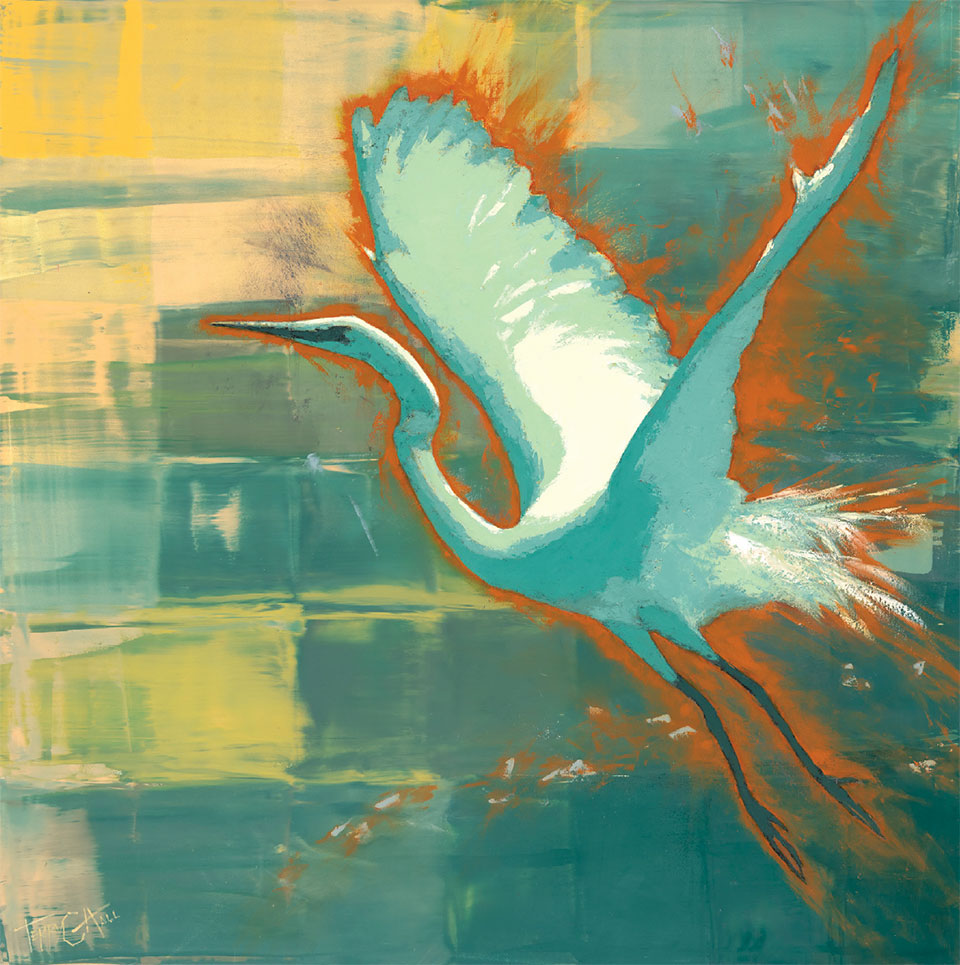
Exuberance | 30” x 30”| Oil & Cold Wax | Terry C Hall
Sanguine Fine Art
Thinking Beyond the Frame
After working together and separately in various creative fields, sisters Terry Hall and Kathi Gerritsen combined their artistic talents to form Sanguine Fine Art & Boutique.
“We thought Sanguine was a good term for us,” Terry says. “It means ‘optimistic,’ and we want to bring that aspect of art into people’s homes.”
While Terry paints with oil and cold wax along with acrylics, Kathi layers digital painting, hand-painting, and photography to create one-of-a-kind pieces.
Their graphic design and shared background grew from working together in the corporate world at an international land planning firm based in San Diego. Later, they exited that environment to form a business designing and painting wall murals, faux finishes, and custom specialty painting for designers, builders, and residential clients.
“We thought Sanguine was a good term for us. It means ‘optimistic,’ and we want to bring that aspect of art into people’s homes.”
–Terry Hall, Artist
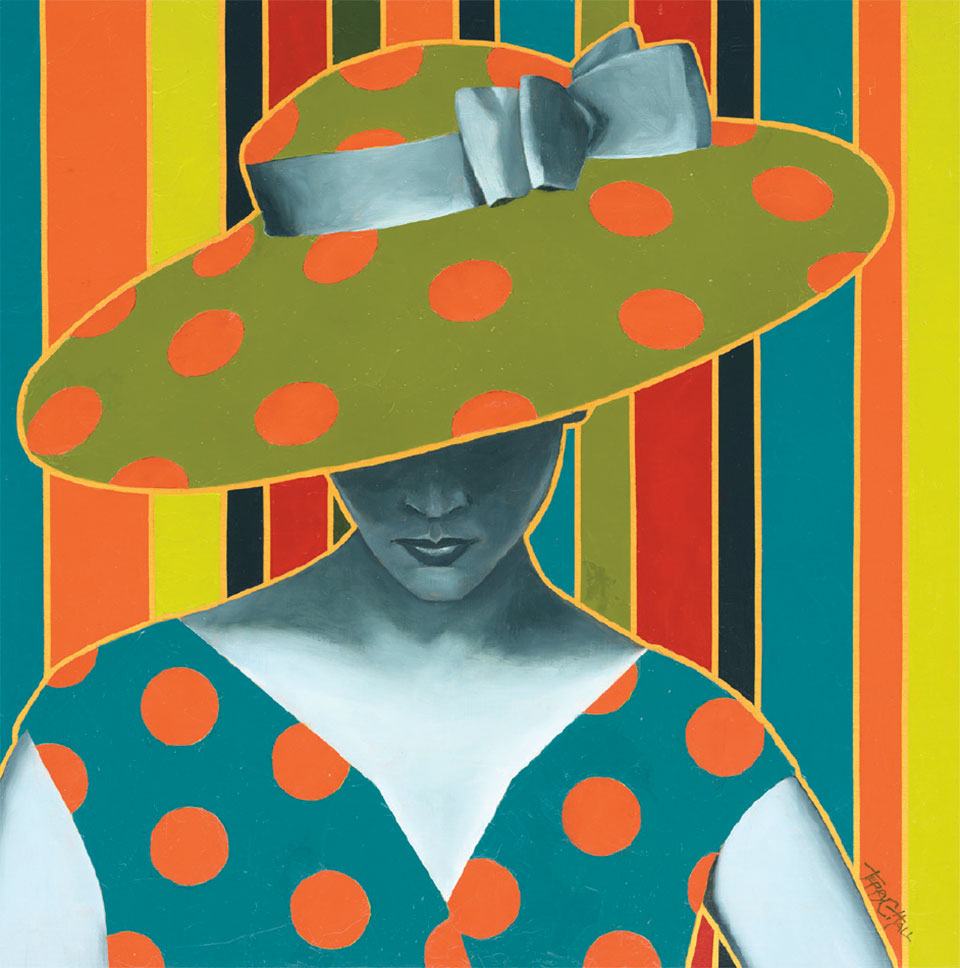
Rodeo Drive | 20” x 20”| Oil on an Acrylic base | Terry C Hall
As sisters, growing up together brought a certain compatibility to their work styles. Simple collaboration became synchronicity. “We have always worked together so this was natural,” Terry says.
“We once worked on a wall mural project together,” Kathi says. “Each of us starting on different ends and meeting in the middle. Our styles were so similar that no one could tell where one started and the other ended.”
Their custom painting enterprise thrived but with young families, working from home became a better fit. Terry gravitated toward oil painting and began submitting art to local galleries. Kathi moved into the tech world, designing marketing material, both print and web.
Sanguine Fine Art & Boutique was born after Terry and family relocated to Montana. She wanted to create an expressive outlet for her art as an alternative to her museum and gallery works. She called Kathi, who helped design an online marketplace that launched in 2020. The sisters then became partners, adding a valuable dimension to Terry’s original idea.
“We once worked on a wall mural project together, Each of us starting on different ends and meeting in the middle. Our styles were so similar that no one could tell where one started and the other ended.”
–Kathi Gerritsen, Artist
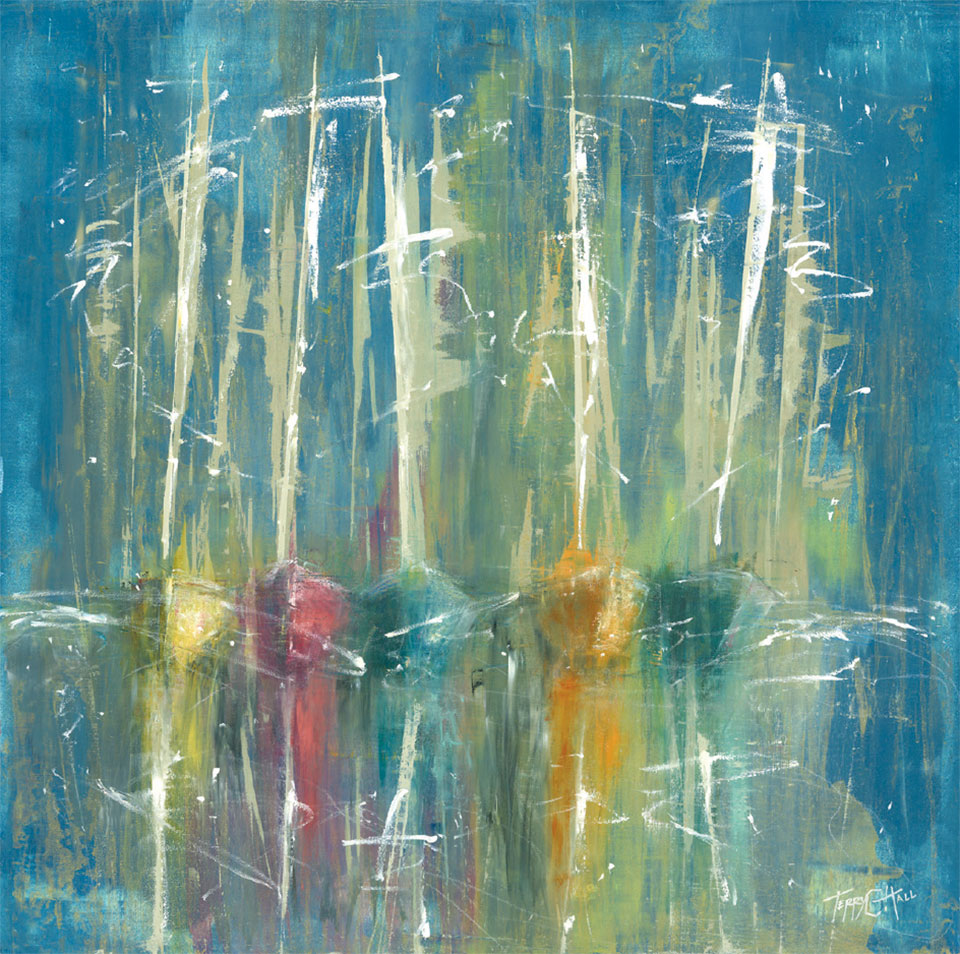
Harbor Lights | 30” x 30”| Oil & Metallics | Terry C Hall
“Our collaboration kind of morphed and now we both contribute to all facets of the business but from different perspectives,” Kathi says.
Terry’s influences come from her graphic design and illustration roots. Her earliest studies were in fashion illustration. Because of that she enjoys painting the figure, some including cultures of the American West, and some illustrating stylized fashion such as “Rodeo Drive.” But she also loves to paint a variety of subjects, integrating her imagination into each, always with the intent to tell a story.
“My designs include concepts to transform a simple subject or object into a bit of a fantastical realm, using abstracted forms and patterns as the backgrounds of my works,” she shares.
Kathi’s style is drawn from her graphic design and computer roots. They are complex but inviting. “I love to mix illustration, photography, and bold, graphic forms,” she says. “Often, I’ll start from a photo base or hand-painted abstract to create texture, then digitally draw or paint subjects that evolve from the background.” An example of her layering technique is found in “Renewal,” a graphic abstract of tulip-like florals. The base layer is a photo of a rusty iron grate found in her husband’s salvage pile. The artwork springs from that.
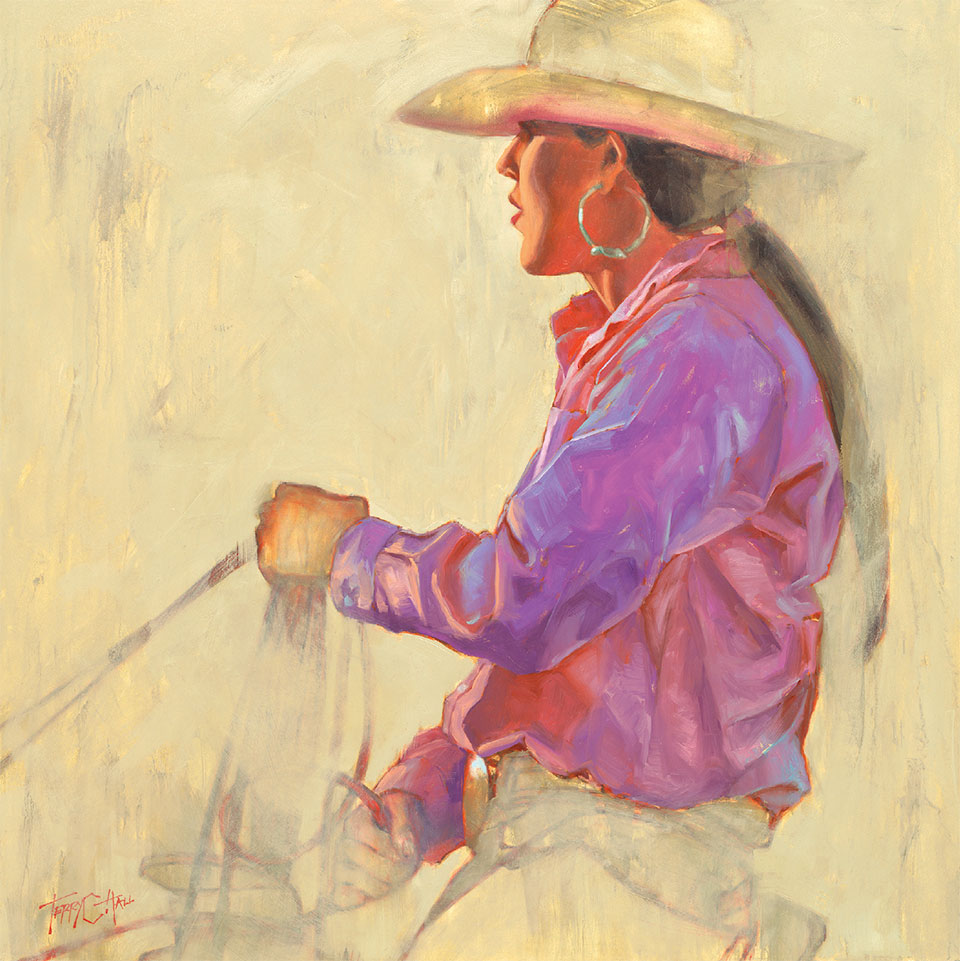
Tango | 30” x 30”| Oil | Terry C Hall
“I really enjoy working on the computer this way,” Kathi says. “It’s fun, stretches my skills, and there’s no clean-up afterwards!”
As for the growth of their business, marketing and finding their audience have been challenging tasks. “We’ve been through some trial and error with our brand,” Terry says. “We started out with a grunge look for our website and social media posts but outgrew it fairly quickly. After some careful thought, we decided to mimic our art style in our marketing, opting for whimsy, color, and fun. That’s what we like, that’s who we are.”
Currently, SFA offers original artwork in a variety of styles but also sells prints in paper, canvas, and metal as affordable alternatives. As their business grows, the sisters plan to expand their product line to include gifts and décor. While they offer aluminum petite prints as gift items, they’ll soon be adding wallpapers, fabrics, wearable art, and greeting cards. To this end, they recently added the “Boutique” moniker in their business name.
They also strive to help buyers understand the relationship between art and its placement, with accent pieces and décor. “We’re a unique boutique business,” Terry says. “We want people to know that they can tell their story with art they buy from us alongside art they already own, but also through memorabilia and meaningful pieces they want to display.”
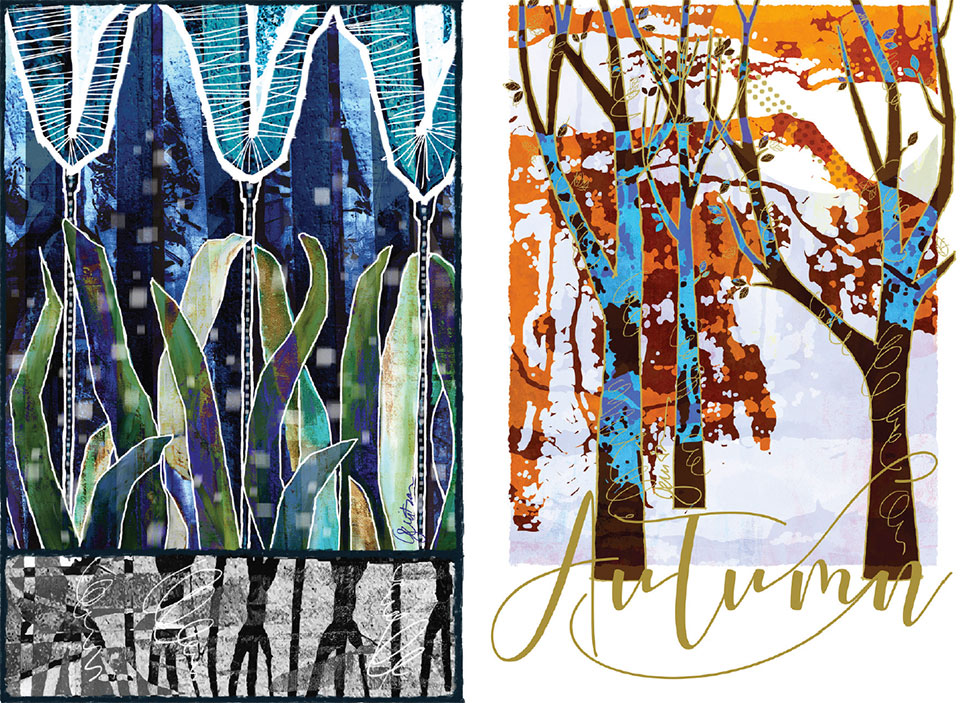
Left: Renewal | Digital Creation on Metal | Kathi Gerritsen
Right: Saratoga Autumn | Digital Creation on Fine Art Paper | Kathi Gerritsen
Kathi adds that they’d like their customers to create places filled with art and precious items that tell the story of their lives or simply make them happy. This leads to an interesting aspect of their business they call “Art Styling.”
“Artwork is a way to connect with an emotional experience,” Terry says. “Simply hanging a piece of art isn’t always going to create that.”
According to Terry and Kathi, Art Styling is a different take on displaying art that truly reflects the client. It’s the concept of telling a person’s life stories by connecting art with memories and important items.
Art Styling might include grouping items with similar or complementary colors; varying sizes of works and heights of placement; and introducing personal items into the mix that reflect the owner’s personality, such as kitschy signage, small mirrors, vintage collections, and travel memorabilia.
“We’re a unique boutique business. We want people to know that they can tell their story with art they buy from us alongside art they already own, but also through memorabilia and meaningful pieces they want to display.”
–Terry Hall, Artist

Left: Terry Hall
Right: Kathi Gerritsen
Terry says the duo likes to educate clients and customers on how to display their new and existing works and treasures to their best advantage. This would include engaging with buyers who contact them with requests for placement or arrangement suggestions.
Education is also cultivated through SFA’s informational blog and social media posts, which might cover tips on framing, color, substrates, and creating interesting art groupings and gallery walls.
“Sometimes, a piece is so strong that it stands alone,” Kathi says. “There’s no additional need to ‘accessorize’. But at other times, Art Styling can happily support your art.”
As Terry adds, “We’re all about personalized, custom-fit creative spaces filled with art and nuance that are as unique as our customers.”
